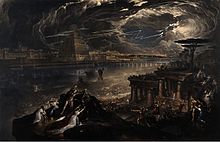
Back سقوط بابل Arabic Caída de Babilonia Spanish Babiloniaren erorialdia Basque سقوط بابل Persian Chute de Babylone French बेबीलोन का पतन Hindi Kejatuhan Babilonia ID 바빌론의 멸망 Korean Kejatuhan Babylonia Malay Val van Babylon Dutch
| Fall of Babylon | |||||||||
|---|---|---|---|---|---|---|---|---|---|
| Part of the Persian conquest of Babylonia | |||||||||
 Cyrus the Great defeating the Babylonian army by John Martin (1831) | |||||||||
| |||||||||
| Belligerents | |||||||||
|
|
| ||||||||
| Commanders and leaders | |||||||||
|
Cyrus the Great Gobryas |
Nabonidus Belshazzar | ||||||||
| Strength | |||||||||
| Unknown | Unknown | ||||||||
Location within modern-day Iraq | |||||||||
The fall of Babylon was the decisive event that marked the total defeat of the Neo-Babylonian Empire to the Achaemenid Persian Empire in 539 BCE.
Nabonidus, the final Babylonian king and son of the Assyrian priestess Adad-guppi,[4] ascended to the throne in 556 BCE, after overthrowing his predecessor Labashi-Marduk. For long periods, he would entrust rule to his son Belshazzar, who was a capable soldier but a poor politician. As a result, he was somewhat unpopular with many of his subjects, particularly the priesthood and the military class.[5] To the east, the Persians had been growing in strength under the leadership of Cyrus the Great, who would soon lead a military expedition into Babylonian territory. In October 539 BCE, after the Battle of Opis, the Persian army made entry into the capital city of Babylon. With the success of Cyrus' campaign, Babylonia was incorporated into the Persian realm as a satrapy. As recorded in the Cyrus Cylinder, Cyrus vowed to respect the Babylonian people and also allowed incarcerated peoples to return to their homelands, most notably including the Babylonians' captives from Judah. Consequently, he was viewed as the legitimate successor of the ancient Babylonian kings, and, unlike Nabonidus, rose to become a popular figure in Babylon itself.[2]
- ^ A Political History of the Achaemenid Empire. M. A. Dandamaev, Moukhammed Abdoulkadyrovitch Dandamaev. 1989. p. 60.
- ^ a b Roux 1992, pp. 381–382; Oates 1986, pp. 134–135.
- ^ Cite error: The named reference
surprise capturewas invoked but never defined (see the help page). - ^ Oates 1986, p. 132.
- ^ Haywood, John (2005). The Penguin Historical Atlas of Ancient Civilizations. London: Penguin Books Ltd. p. 49.
© MMXXIII Rich X Search. We shall prevail. All rights reserved. Rich X Search
